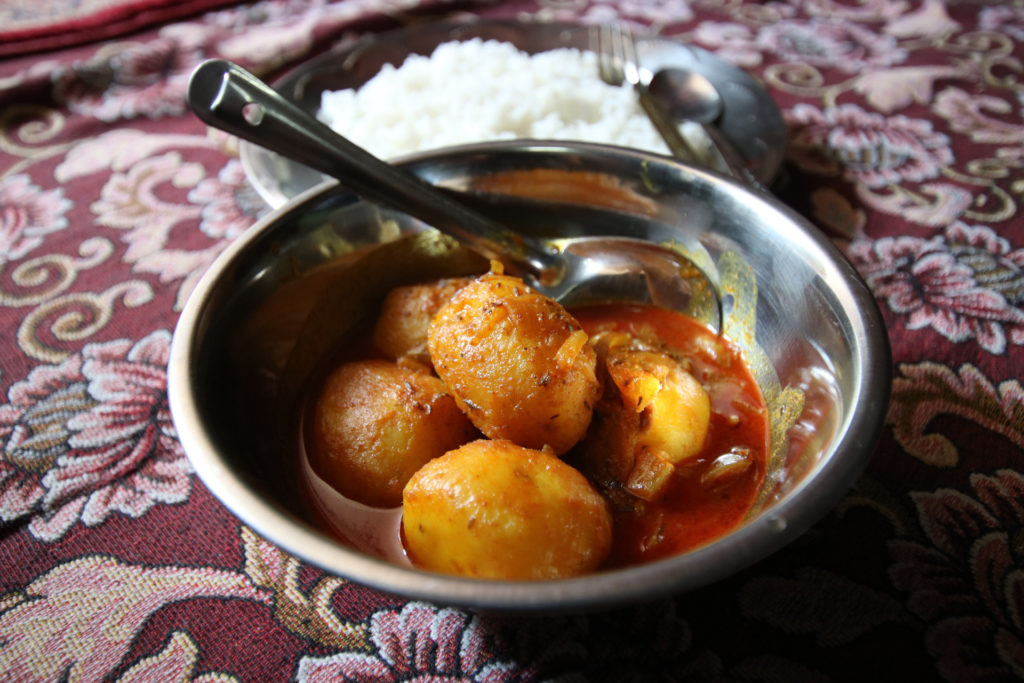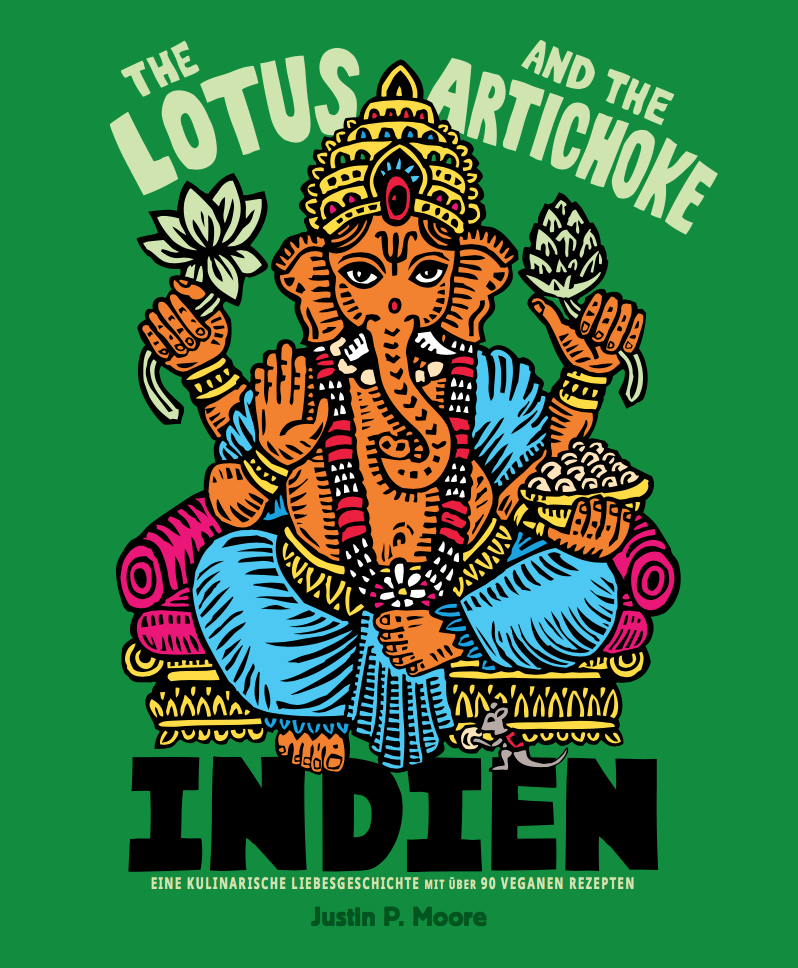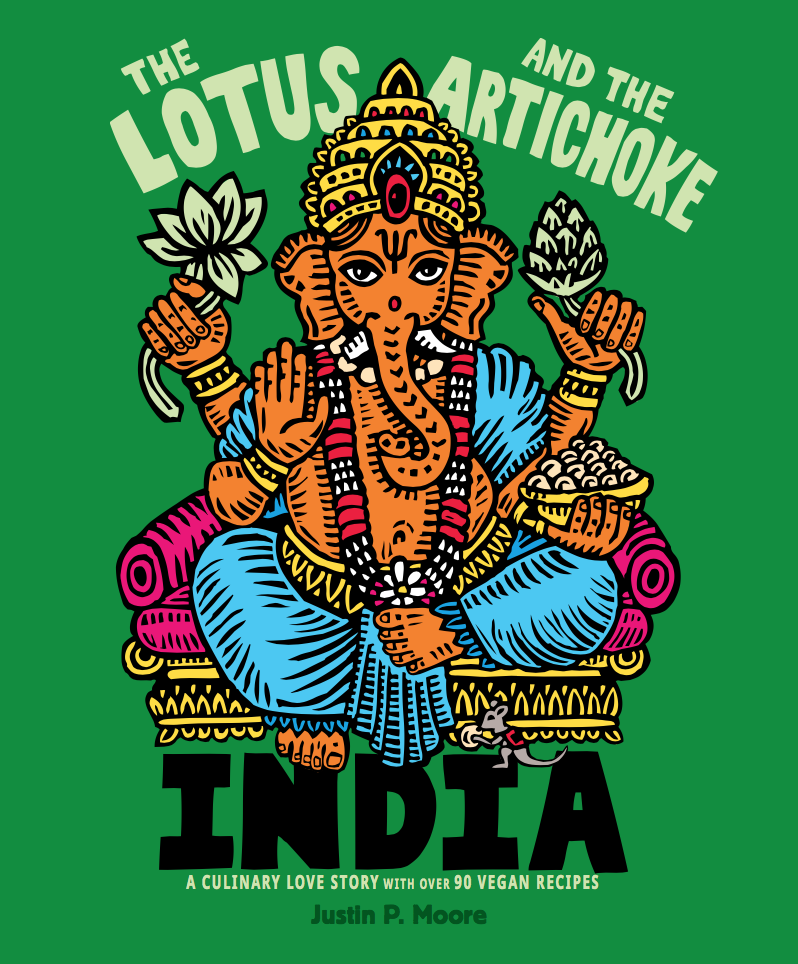
My original recipe for Dum Aloo appeared in the first edition of The Lotus and the Artichoke – Vegan Recipes from World Adventures back in 2012 (and 2013 for the German edition). It was based on how I learned to cook Dum Aloo when I was living in Amravati, India. When I re-did my first cookbook for the WORLD 2.0 edition, I decided to drop this recipe as I’d improved it already for The Lotus and the Artichoke – INDIA.
On a subsequent visit to India, in late 2017, when I spent some time in and around Srinagar, Kashmir, I learned how to make the traditional Kashmiri version of the dish – which typically does not include tomatoes. I’ve had many friends from other regions of India assure me that it can be (and often is) made with tomatoes, so I was initially naturally rather confused to get somewhat regular feedback from Kashmiris telling me that it is not made with tomatoes (or onions, depending on who you ask). It was explained to me that in the far northern, mountainous regions of India it was often impossible to get tomatoes (and onions) in the winter, when the roads were socked in with snow… and to make a long story short: tomatoes (and onions) were added to the dish in other parts of India, but it was not authentic Kashmiri!
These debates always bring to mind the dozens of times I’ve heard arguments about what exactly belongs – or doesn’t belong – in garam masala spice mixes (every household has a different recipe, usually only theirs is legitimate and bona fide; others bring weird, or wrong). And as I’m not in a position to determine what is or is not ‘authentic’ (nor is it of particular appeal to me to do so, especially in cultural, culinary contexts), I prefer to focus on what has been taught to me, and always mention that the authenticity is discussed and debated. As a rule, when I change things, it’s important to me to address it, and I’d like to emphasize that my dishes are inspired by what I’ve been taught and tasted, but I do adapt things here and there to make them practical (or possible) and accessible beyond the regions where they originate.
Outside of Kashmir, and outside of India, it is of course possible to make this dish without tomatoes in the base sauce, but I personally appreciate the texture and (fruity, sour, sweet) flavors tomatoes lend. (Again, I’ve also had it prepared for me both in Kashmir and other parts of India with tomatoes and onions. And I’ve had cooks insist that they must be in the dish.) But if you object, and/or fancy yourself to be a purist, by all means, omit them, use my provided variations – or just shake your fist in the air and look further for another recipe!
In any event, this recipe uses just one small tomato and one small onion, so it’s kind of a compromise. My recipe, being vegan, also does not include (dairy) yogurt or cream as many (but not all) North Indian manifestations of Dum Aloo or Aloo Dum do. I also cook variations with a creamy cashew base (this having been taught to me in Maharashtra) but I typically save the blended tomatoes and cashew trick for Paneer Makhani, which features fried tofu-paneer instead of potatoes… and much less (Kashmiri) red chili powder – or mild ground paprika, if you’re not up for the heat.
I’d like to extend my special thanks to my friends in Srinagar for showing me how to make this dish on a quiet afternoon some years ago when we were quite hungry and anxious for something fun to do. In the midst of a state-wide shutdown and a tense security situation I was one of very few foreigners in Srinagar, and was staying a week with Nazeer’s family on a houseboat. All the restaurants pretty much everywhere were closed (as well as the shops, except a few that had the gates partially up and lights on low at night, cautiously) but I managed to meet up with some Kashmiri guys at a nearby guesthouse, and this is what we cooked up together. The photo for this recipe is actually from that cooking session!
Dum Aloo
Kashmiri potato curry
serves 2 to 3 / time 30 min
recipe from The Lotus and the Artichoke – INDIA
(Rezept auf Deutsch unten)
- 12–15 very small or 3 medium (400 g) potatoes
- 1 small (75 g) tomato chopped
- 1 small (60 g) red onion chopped
- 2 cloves garlic chopped
- 3/4 in (2 cm) fresh ginger chopped
- 1 cup (240 ml) water
- 3 Tbs vegetable oil
- 1/2 tsp cumin ground
- 1/2 tsp coriander ground
- 1 tsp Garam Masala (page 32)
- 1/2 tsp red chili powder optional
- 1 tsp paprika ground
- 1/2 tsp turmeric ground
- 1/4 tsp asafoetida (hing) powder
- 1 Tbs lime juice
- 1 tsp sugar or agave syrup
- 1 1/2 tsp sea salt
- Rinse and peel potatoes. Chop in large chunks.
- In a small food processor or blender, grind chopped tomato, onion, garlic, ginger with 1/2 cup (120 ml) water until mostly smooth.
- Heat oil in a large pot or wok on medium heat. Add potatoes. Fry until evenly deep golden brown, stirring frequently, 7–10 min.
- Add garam masala, ground cumin, coriander, red chili powder (if using), paprika, turmeric, and asafoetida (hing). Mix well. Fry until richly aromatic, 1-2 min.
- Stir in blended tomato mix. Bring to boil. Reduce heat to medium low. Simmer, stirring regularly, until potatoes are soft, sauce is deep red, and oil separates, 7–10 min. Stir in another 1/2 cup (120 ml) water gradually while simmering.
- Stir in lime juice, sugar (or agave syrup), and salt. Cover and remove from heat.
- Serve with rice, roti, or naan.
Variations:
Traditional: Replace tomato with 4 Tbs soy or coconut yogurt. Saffron Gold: Mix 2 Tbs soy yogurt, 1 Tbs water, and pinch saffron threads or powder in a small bowl. Soak 10 min. Stir into curry with lime juice at the very end. Aloo Mutter Dum: Add 1 cup green peas and a handful of chopped fresh coriander leaves for last few minutes of simmering.

Aloo Dum
Kartoffel-Curry aus Kaschmir
2 bis 3 Portionen / Dauer 30 Min.
Rezept aus The Lotus and the Artichoke – INDIEN
- 12–15 sehr kleine oder 3 mittelgroße (400 g) Kartoffeln
- 1 kleine (75 g) Tomate gehackt
- 1 kleine (60 g) rote Zwiebel gehackt
- 2 Knoblauchzehen gehackt
- 2 cm frischer Ingwer gehackt
- 1 Tasse (240 ml) Wasser
- 3 EL Pflanzenöl
- 1/2 TL Kreuzkümmel gemahlen
- 1/2 TL Koriander gemahlen
- 1 TL Garam Masala (Seite 32)
- 1/2 TL Chilipulver wenn gewünscht
- 1 TL Paprikapulver
- 1/2 TL Kurkuma gemahlen
- 1/4 TL Asafoetida (Asant)
- 1 EL Limettensaft
- 1 TL Zucker oder Agavensirup
- 1 1/2 TL Meersalz
- Kartoffeln waschen, schälen und in große Stücke schneiden.
- In einer kleinen Küchenmaschine oder einem Mixer gehackte Tomate, Zwiebel, Knoblauch, Ingwer und 1/2 Tasse (120 ml) Wasser fast glatt pürieren.
- In einem großen Topf oder Wok Öl auf mittlerer Flamme erhitzen. Kartoffeln hineingeben. Unter häufigem Rühren 7 bis 10 Min. tief goldbraun braten.
- Garam Masala, gemahlenen Kreuzkümmel, Koriander, Chilipulver (falls verwendet), Paprikapulver, Kurkuma und Asafoetida hinzufügen. Gut umrühren und 1 bis 2 Min. braten, bis es aromatisch duftet.
- Tomatenmischung einrühren. Zum Kochen bringen. Flamme herunterstellen. 7 bis 10 Min. unter regelmäßigem Rühren köcheln, bis die Kartoffeln weich sind, die Soße tiefrot ist und das Öl sich trennt. Während des Köchelns eine weitere 1/2 Tasse (120 ml) Wasser einrühren.
- Limettensaft, Zucker (oder Agavensirup) und Salz einrühren. Abdecken und vom Herd nehmen.
- Mit Reis, Roti oder Naan servieren.
Variationen:
Traditionell: Tomate mit 4 EL Soja- oder Kokosjoghurt ersetzen. Safrangold: In einer kleinen Schüssel 2 EL Sojajoghurt, 1 EL Wasser und 1 Prise Safranfäden oder -pulver verquirlen. 10 Min. einweichen. Am Ende zusammen mit dem Limettensaft ins Curry einrühren. Aloo Mutter Dum: 1 Tasse grüne Erbsen und eine Handvoll frisches gehacktes Koriandergrün während der letzten Kochminuten unterrühren.


